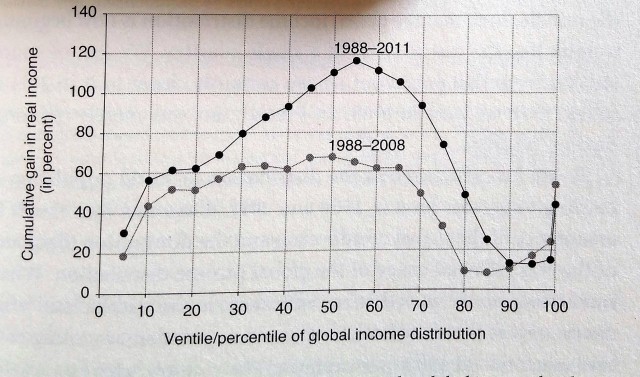Global inequality is composed of inequality between countries and inequality within countries. We can describe inequality within countries by “Kuznets waves”. Inequality first rises as a country grows richer and when it has achieved a certain income level, inequality gradually decreases. The theory fails to explain though why inequality has risen in developed countries since 1990, notably in the US, but also in Europe. Milanovic introduces the concept of Kuznets cycles, rather than waves. Benign and malign forces drive inequality up or down. High inequality is unsustainable and creates the seeds for destructive events that reduce it, but in their wake also destroy much else.
Forces that push inequality up are:
- higher returns on capital than labour (Piketty factor)
- high incomes from labour and capital are increasingly concentrated in the same peoplez
- technological innovation that favours the rich (capital rents, higher wage dispersion)
- decreasing power of unions (due to changing labour markets)
- high availability of labour (opening up of China, India and USSR in 1990s)
- increasing scalability and emergence of more winner-takes-all markets (e.g. education)
- capture of political process (democracy) and media by the rich
- monopolisation of sectors
Forces that reduce inequality are (malign or benign)
- investment in public education
- redistribution of wealth through progressive taxes or social programmes
- wars, epidemics and natural disasters (World Wars or the Plague in medieval times)
- scarcity of labour (can be reduced by immigration)
- technological innovation that favours the poor (speculative)
Although inequality has been rising in developed countries, at the global level it has been decreasing for quite some time. This is mainly due to the rise of China and, to a lesser extent, other Asian countries (India, Indonesia, Vietnam, Thailand). This has come mainly at the expense of the lower middle class in Western countries. The figure below shows how the 99th percentile (global plutocrats) and 50th-60th percentile (upper middle class in Asia) has done well during the last 20 years, whereas the 80th-90th percentile saw its income stagnating. He notes that, as China grows richer, it will in the near future contribute to global inequality, rather than being a reducing force.
Lower inequality between countries reduces the “citizenship rent”, the importance of where one is born for whether will be rich or not. This does not mean that the “lottery of birth” becomes less important, as social mobility within countries has been decreasing. However, in our (Western) discourse about rising inequality, it is important to note that on a global level, inequality is actually going down. The decrease is mainly due to the rise of Asia, Africa is not contributing at all.
Milanovic discusses some of the consequences of high inequality. On migration, which he sees as an inevitable consequence of globalization, he advocates (as Collier does) for limited access to citizenship rights (temporary worker status, higher taxes) to compensate for their higher productivity as a result of migration and access to a superior social model. On politics, he sees plutocracy (the US option) and populism (the EU option) as consequences of high inequality and the reduced size of the middle class. A smaller middle class results in lower support for public services such as health and education and more attention for internal security and defense. The slide away from democracy is masked by shifting attention to issues such as nationalism and identity and by overestimating social mobility. He refers to the work of Jan Tinbergen who showed how returns on education are highest in poor countries, where few people have access to higher education. In developed countries, access to education is widespread, the return decreases, but connections and sheer luck determine who gets access to well-paying jobs.
Milanovic present an impressive range of data and charts to make his case. It is not an optimistic book, as he doesn’t see many benign forces that are strong enough to reduce inequality, especially in the US.
